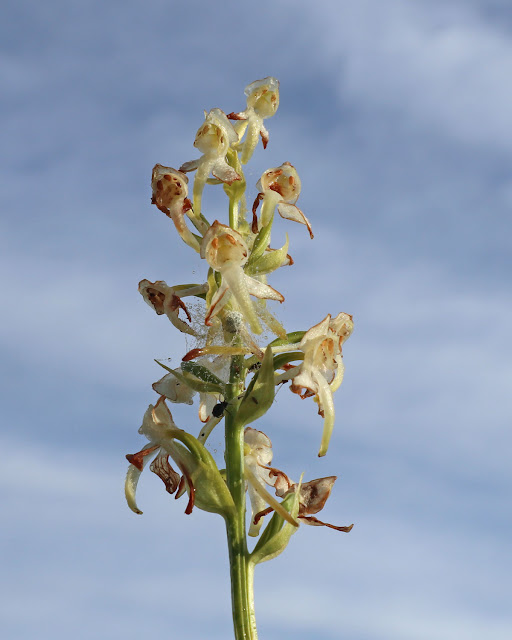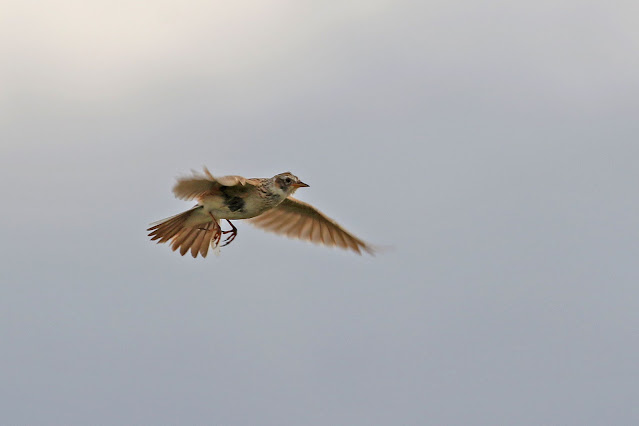Lesser Whitethroats are smaller than whitethroats and have shorter tails and plain-coloured wing edges. The Lesser Whitethroat is a medium-sized warbler of dense scrub and woodland It is a secretive bird, so is most easily located by its rattling, monotonous song. This is one of the reasons why to see them is an special moment.
Male and female Lesser Whitethroats are very similar. They are greyish-brown above and creamy-grey below, with grey heads, dark grey cheeks or 'masks', white throats and white chests.
We headed south towards the Bokerly Ditch, the path is lined with hawthorn bushes and the long grass was very wet from the rain on the day before. A Yellowhammer sang fro the top of a hedge just caught by the rising sunshine.
A little further along a Whitethroat singing.
There was plenty of bird song about but at first not the song we were hoping to hear. In past years we have been able to hear the Turtle Dove purring from the car park, in more recent summers this has not been the case and it has required a search around the denser scrub and bushes.
Then as we got closer to the scrub I could just make out the distinctive purring call. It seemed to be coming from the same area as we had seen one last year. The hope was that it would be singing from a prominent position at the top of the bushes. It was almost impossible to get inside the scrub.
We found it sitting fortunately at the top of the trees, but a way from the edge, almost in the middle of the copse.
Here the puffed up throat and crop while it "purrs"
It then moved into the branches but fortunately was still clearly visible
When I first started coming here to see these doves there were counts of over 6 pairs, today we could hear two singing, and there was another from the next set of scrub along the ditch.
I hadn't seen them on two previous visits this year, probably because we arrived much later in the day, it would seem they like to call early in the morning, taking in the sunshine at the top of the trees
The sun was slowly making its way in the sky, sending shadows across the down and turning the damp grass to almost a frosty appearance. The path here rises slowly and looking back there are some wonderful views across the down towards the village of Martin.
As we reached the Ditch we could see the second of our targets today, a Greater Butterfly Orchid on the bank of the ditch. It was surrounded by Common Spotted Orchids and as we approached we could see immediately the light was going to be both a hindrance and and a benefit.
Here with the light behind me
The Greater butterfly-orchid is a distinctive plant of hay meadows, grasslands and ancient woodlands on chalk soils. Here a view with the wet grassland behind it lit up by the sunshine
Its flower spike can grow quite tall, displaying up to 30 whitish-green flowers in a loose cluster from May to July. The spreading sepals and petals of the flowers look a bit like the wings of a butterfly. Here a little back light emphasising the sepals and petals
But also providing a jewel like background.
I always find some of the naming of these orchids a bit strange, I can see why a butterfly, but I don't really think it looks much like a butterfly.
Here surrounded by more jewelry
The bank the orchid was on provided some more elevation that allowed us more views out across the village of Martin and beyond. Lovely misty views enhanced by the low early morning sunshine.
Turning slightly the monochrome gives up some colour along with long shadows
Then looking west along the ditch towards the rifle ranges and the direction we would be taking
We came down the bank but didn't get very far as we came across another Greater Butterfly Orchid, this time its location meant that it was lit by the sun against a dark black background.
The water droplets on the spider's silk looking like tiny jewels in amongst the petals
A stunning background
Tucked away on the bank was what we thought at first was a group of more Common Spotted Orchids but on closer look was a Fragrant Orchid, in fact a Chalk Fragrant Orchid. Elegant spikes with up to 200 individual flowers which are often a vivid pink, but can vary from purple to white, are held on a leafy and robust stem. The stem has a striated surface and the grey-green leaves are long, narrow and lanceolate.
The forecast for the day was a little mixed, the early morning sunshine had given way to a build up of clouds, some of which were looking very dark and heavy away to the west. The sun though remained out for the time being and a Yellowhammer sang from a worn post with the grey clouds as a backdrop. Slowly we made our way in to get as close as we could.
Probably one of my best Yellowhammer shots, capturing the song without hearing it
We decided to check the other side of the ditch as a butterfly disappeared over the bank and was presented with a smaller crop of poppies flowering in a Rapeseed filed taht had gone completely to seed.
They benefit from some cloud in the sky
On reaching the rifle ranges we walked around the various shorter grass fields in between the mounds. There were many more orchids dotted amongst the yellow buttercups and Bird's foot Trefoil that at first we thought were Common Spotted but on closer inspection were Chalk Fragrant Orchids.
The Fragrant-orchid is a robust, medium-sized orchid found on dry and damp grasslands, particularly with chalky soils. In bloom during June and July, the fragrant-orchid lives up to its name by producing a sweet, orangey smell that is particularly strong in the evening.
Quite a frequent species of chalk and limestone grassland in England and Wales. It is found in mildly damp, upland meadows and pastures, grassland and fens and also quarries and railway banks.
Our walk then took us past the top car park and over the road the the reserve on the other side. This is when the butterflies really started to appear and this will be documented in full in Part Two of today's blog.
Coming back into the main reserve on the other side we came across a singing Lesser Whitethroat again. This time last year we had encountered one in precisely the same place but it had not been very cooperative. This time though, it showed very well as it sang and searched for food amongst the bushes.
Here, the best view of a Lesser Whitethroat I have photographed
We walked back through the Rifle ranges once again and came across these Common Spotted Orchids.
The Common spotted-orchid is the most common of all UK
orchids and the one you are most likely to see. It grows in many different
habitats, including woodland, roadside verges, hedgerows, old quarries, sand
dunes and marshes; sometimes so many flowers appear together that they carpet
an area with their delicate, pale pink spikes. It is in bloom between June and
August.
The orchid gets its name from its leaves, which are green
with many purple, oval spots. They form a rosette at ground level before the
flower spike appears; narrower leaves sheath the stem. The flowers range from
white and pale pink, through to purple, but have distinctive darker pink spots
and stripes on their three-lobed lips.
After lunch in the car park we decided to make our way to Shatterford, our intent was to find the Silver-studded Blues, but at the same time there was the opportunity to catch up with some birds too.
After crossing the heath we came into Denny Wood and immediately there were Redstarts, young birds calling and a male trying to keep them fed. They were extremely mobile and we only managed to get good views of the male distantly in a tree.
We walked through the wood coming across a collection of Robins, Song Thrushes and a singing Firecrest. A Treecreeper was also searching for fod on the bark of a large Oak tree.
Coming out of the wood we crossed the boggy area which was as dry as I can remember seeing it. The pool though still had sufficient water to support a Little Egret, several Lapwing and a Pied Wagtail
Ian found another Redstart along a line of trees from a bridge. It gave us the run around though and I could only manage this record flight shot as it dropped to the ground and picked something up before flying off and out of sight.
We can only assume that the dry spring weather has impacted the dragonfly population here. There was still water in the bogs but we only managed to find one male Broad-bodied Chaser. At this time of year we would have expected many more.
As we approached the railway bridge, a call that was definitely a wader's stopped us and a little further a Curlew flew up. It is sometime since I have seena Curlew here in summer time and maybe it was nesting. The car park was closed due to the fact that birds were nesting closer to the car park area following the quiet of lock down.
Again there was plenty of water in the bog to support the cotton grass but no sign of any dragonflies. This may well have been due to the now overcast conditions, but doesn't account for the other areas. The cotton grass against the cloudy skies depicted the moody moor like nature of this area.
That was it for Part One, it was good to catch up with the Turtle Dove at last, and the orchids were impressive, as was the the early morning landscapes on a really special place.

























































No comments:
Post a Comment